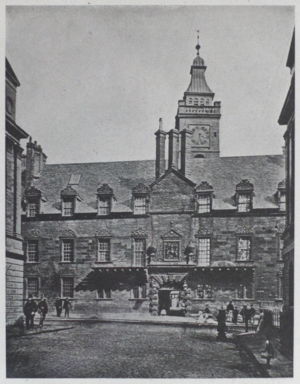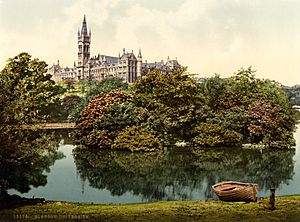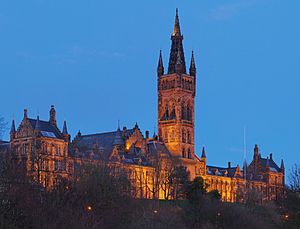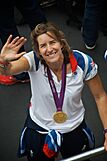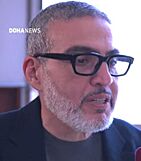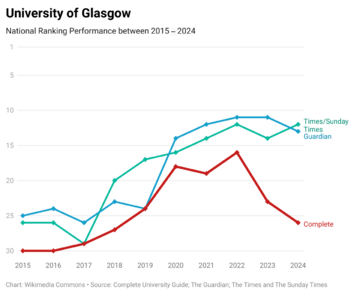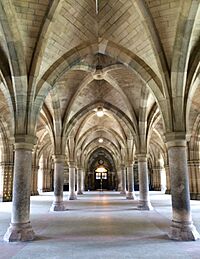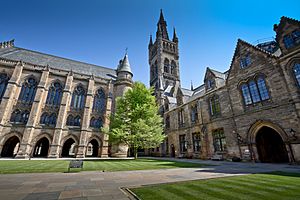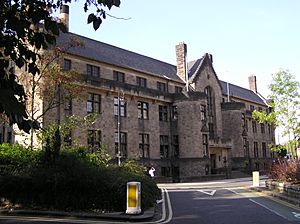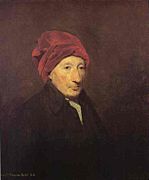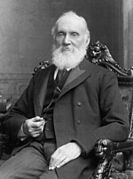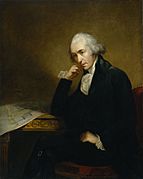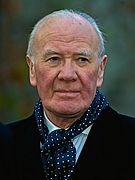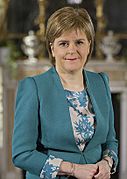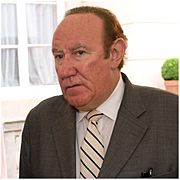University of Glasgow facts for kids
|
Scottish Gaelic: Oilthigh Ghlaschu
|
|||||||||||||||||||||||||||||||||||||||||||||||||||||||||||||||||||||||||||||||||||||||||||||||||||||||||||||||||||||||||||||||||||||||||||
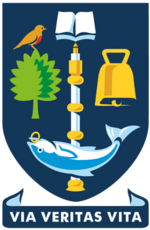
Coat of arms
|
|||||||||||||||||||||||||||||||||||||||||||||||||||||||||||||||||||||||||||||||||||||||||||||||||||||||||||||||||||||||||||||||||||||||||||
| Latin: Universitas Glasguensis | |||||||||||||||||||||||||||||||||||||||||||||||||||||||||||||||||||||||||||||||||||||||||||||||||||||||||||||||||||||||||||||||||||||||||||
| Motto | Latin: Via, Veritas, Vita | ||||||||||||||||||||||||||||||||||||||||||||||||||||||||||||||||||||||||||||||||||||||||||||||||||||||||||||||||||||||||||||||||||||||||||
|---|---|---|---|---|---|---|---|---|---|---|---|---|---|---|---|---|---|---|---|---|---|---|---|---|---|---|---|---|---|---|---|---|---|---|---|---|---|---|---|---|---|---|---|---|---|---|---|---|---|---|---|---|---|---|---|---|---|---|---|---|---|---|---|---|---|---|---|---|---|---|---|---|---|---|---|---|---|---|---|---|---|---|---|---|---|---|---|---|---|---|---|---|---|---|---|---|---|---|---|---|---|---|---|---|---|---|---|---|---|---|---|---|---|---|---|---|---|---|---|---|---|---|---|---|---|---|---|---|---|---|---|---|---|---|---|---|---|---|---|
|
Motto in English
|
The Way, The Truth, The Life | ||||||||||||||||||||||||||||||||||||||||||||||||||||||||||||||||||||||||||||||||||||||||||||||||||||||||||||||||||||||||||||||||||||||||||
| Type | Public research university Ancient university |
||||||||||||||||||||||||||||||||||||||||||||||||||||||||||||||||||||||||||||||||||||||||||||||||||||||||||||||||||||||||||||||||||||||||||
| Established | 7 January 1451 | ||||||||||||||||||||||||||||||||||||||||||||||||||||||||||||||||||||||||||||||||||||||||||||||||||||||||||||||||||||||||||||||||||||||||||
| Endowment | £262.4 million (2024) | ||||||||||||||||||||||||||||||||||||||||||||||||||||||||||||||||||||||||||||||||||||||||||||||||||||||||||||||||||||||||||||||||||||||||||
| Budget | £950.0 million (2023/24) | ||||||||||||||||||||||||||||||||||||||||||||||||||||||||||||||||||||||||||||||||||||||||||||||||||||||||||||||||||||||||||||||||||||||||||
| Chancellor | Dame Katherine Grainger | ||||||||||||||||||||||||||||||||||||||||||||||||||||||||||||||||||||||||||||||||||||||||||||||||||||||||||||||||||||||||||||||||||||||||||
| Rector | Ghassan Abu-Sittah | ||||||||||||||||||||||||||||||||||||||||||||||||||||||||||||||||||||||||||||||||||||||||||||||||||||||||||||||||||||||||||||||||||||||||||
| Principal and Vice-Chancellor | Sir Anton Muscatelli | ||||||||||||||||||||||||||||||||||||||||||||||||||||||||||||||||||||||||||||||||||||||||||||||||||||||||||||||||||||||||||||||||||||||||||
|
Academic staff
|
5,795 (2023/24) | ||||||||||||||||||||||||||||||||||||||||||||||||||||||||||||||||||||||||||||||||||||||||||||||||||||||||||||||||||||||||||||||||||||||||||
|
Administrative staff
|
4,660 (2023/24) | ||||||||||||||||||||||||||||||||||||||||||||||||||||||||||||||||||||||||||||||||||||||||||||||||||||||||||||||||||||||||||||||||||||||||||
| Students | (2015/16) 32,620 FTE (2015/16) |
||||||||||||||||||||||||||||||||||||||||||||||||||||||||||||||||||||||||||||||||||||||||||||||||||||||||||||||||||||||||||||||||||||||||||
| Undergraduates | (2015/16) | ||||||||||||||||||||||||||||||||||||||||||||||||||||||||||||||||||||||||||||||||||||||||||||||||||||||||||||||||||||||||||||||||||||||||||
| Postgraduates | (2015/16) | ||||||||||||||||||||||||||||||||||||||||||||||||||||||||||||||||||||||||||||||||||||||||||||||||||||||||||||||||||||||||||||||||||||||||||
| Location | , | ||||||||||||||||||||||||||||||||||||||||||||||||||||||||||||||||||||||||||||||||||||||||||||||||||||||||||||||||||||||||||||||||||||||||||
| Flag |  |
||||||||||||||||||||||||||||||||||||||||||||||||||||||||||||||||||||||||||||||||||||||||||||||||||||||||||||||||||||||||||||||||||||||||||
| Colours |
More
Arts
Dentistry Divinity Engineering Law Medicine Nursing Science Social Sciences |
||||||||||||||||||||||||||||||||||||||||||||||||||||||||||||||||||||||||||||||||||||||||||||||||||||||||||||||||||||||||||||||||||||||||||
| Affiliations |
|
||||||||||||||||||||||||||||||||||||||||||||||||||||||||||||||||||||||||||||||||||||||||||||||||||||||||||||||||||||||||||||||||||||||||||
 |
|||||||||||||||||||||||||||||||||||||||||||||||||||||||||||||||||||||||||||||||||||||||||||||||||||||||||||||||||||||||||||||||||||||||||||
The University of Glasgow is a big public university in Glasgow, Scotland. People sometimes call it Glas. for short. It was started way back in 1451 by a special paper from the Pope, making it one of the oldest universities in the world that's still running. It's also one of Scotland's four "ancient universities."
During the 1700s, the university was a key part of the Scottish Enlightenment. This was a time when many new ideas in science, philosophy, and economics came from Scotland. Today, Glasgow is the second-largest university in Scotland by student numbers. It is also one of the biggest in the United Kingdom.
At first, the university mainly taught students from rich families. But in the 1800s, it started to welcome students from the growing middle class too. It helped prepare students for jobs in law, medicine, teaching, and the church. It also trained people for careers in science and engineering.
The University of Glasgow has a large amount of money saved up, which is called an endowment. It's the fifth-largest among UK universities. In the 2023–2024 school year, the university's income was £950 million. A big part of this, £221.1 million, came from money for research projects.
The university is part of important groups like Universitas 21, the Russell Group, and the Guild of European Research-Intensive Universities. These groups connect top research universities around the world.
The university was first located on High Street in Glasgow. Since 1870, its main campus has been at Gilmorehill in the city's West End. Some other university buildings are in different places. For example, the Veterinary School is in Bearsden. There is also the Crichton Campus in Dumfries.
Many famous people have studied at the University of Glasgow. These include James Wilson, who signed the United States Declaration of Independence. Three Prime Ministers of the UK also studied here: William Lamb, Henry Campbell-Bannerman, and Bonar Law. Three Scottish First Ministers, Humza Yousaf, Nicola Sturgeon, and Donald Dewar, are also alumni. Other famous names include economist Adam Smith, engineer James Watt, and physicist Lord Kelvin. The university has also had eight Nobel Prize winners connected to it. Many Olympic gold medalists, like the current Chancellor Dame Katherine Grainger, have also studied here.
Contents
History of the University
The University of Glasgow was officially started in 1451. This happened when Pope Nicholas V gave permission to Bishop William Turnbull to create a university. King James II had suggested this idea. It was the second university in Scotland, after St Andrews. It is also the fourth oldest university in the English-speaking world.
The original paper that started the university, called the "Bull," was lost in the 1500s. During a time of political trouble, the Archbishop James Beaton took many important university papers to France for safety. Even though some items were returned later, the original Bull was not. It was likely lost during the French Revolution. However, the university still uses this original Bull as the authority to give out degrees.
Teaching first began in the Glasgow Cathedral. Later, the university moved to a building called the "Auld Pedagogy." In 1563, Mary, Queen of Scots gave the university land on High Street. By the late 1600s, the university had a grand building with two courtyards and a tall clock tower. This tower was a famous part of Glasgow's skyline. Some parts of this old building, like the "Pearce Lodge" and the Lion and Unicorn Staircase, were moved to the new Gilmorehill campus to save them.
John Anderson, a professor at the university, was a pioneer in teaching working men and women. He wanted to help people learn skills for the Industrial Revolution. He later started "Anderson's College," which eventually became the University of Strathclyde.
In 1973, Delphine Parrott became the first female professor at the university. In 2014, the university decided to stop investing in companies that use fossil fuels. This was a big step for a university in Europe.
University Campuses
The University of Glasgow has several campuses. The main one is the Gilmorehill campus in Hillhead. There is also the Garscube Estate in Bearsden. This is where the Veterinary School, the Observatory, and many sports facilities are located. The Dental School is in the city center. Other parts of the university are at Gartnavel Royal Hospital and the Queen Elizabeth University Hospital. The Crichton Campus in Dumfries is run with other universities.
In 2017, the Imaging Centre of Excellence (ICE) opened at the Queen Elizabeth University Hospital. This center has a special area for researchers and businesses to work together.
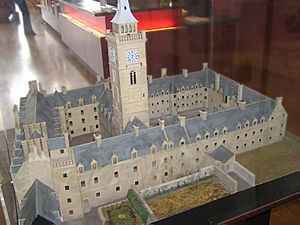
High Street Campus
The university's first home was near Glasgow Cathedral. In 1460, it received land on the east side of High Street. For the next 400 years, this was its main location. In the mid-1600s, a beautiful new building with two courtyards was built. It was considered one of the best buildings in Scotland at that time. Some parts of this old building were saved and moved to the new campus later.
Over time, the university grew a lot. It built the Macfarlane Observatory in 1757. Later, it opened Scotland's first public museum, the Hunterian. The area around the university on High Street became very crowded. This led the university to look for a new, bigger location.
Gilmorehill Campus
In 1870, the university moved to Gilmorehill in the West End of Glasgow. This new campus was designed by Sir George Gilbert Scott in a Gothic revival style. The main building looks like a grand castle with two courtyards. In 1879, a large hall called Bute Hall was added. A tall spire was added to the main tower in 1887, making it about 278 feet tall. The building looks old, but it was built with modern steel frames inside. It is the second-largest Gothic revival building in Britain.
The university's Hunterian Museum is in the Main Building. The Hunterian Gallery is nearby and includes "The Mackintosh House." This is a rebuilt house designed by the famous architect Charles Rennie Mackintosh.
Even with the new campus, the university kept growing. In the 1930s, a round Reading Room was built. The university also bought many Victorian houses and connected them to make more space. Departments like Psychology and Computing Science are still in these converted houses.
More buildings were added for science and medicine. The veterinary school moved to a new campus in Garscube in 1954. The university also moved its sports facilities and built student housing there.
In the 1960s, many modern buildings were constructed on Gilmorehill. Some of these were in the brutalist style, like the Rankine Building and the Adam Smith Building. A new library and other tower blocks were also built. To feed all the students, a new dining hall called the Hub opened in 1966.
In 2001, the Bower Building was damaged by fire. It was rebuilt and reopened in 2004. The Wolfson Medical School Building opened in 2002. In 2003, the St Andrews Building opened for the School of Education. The Sir Alwyn Williams building, for Computing Science, was finished in 2007.
In 2016, the Kelvin Hall was updated to include the Hunterian Collections and Study Centre. A new 'Learning Hub' for students opened in 2021. It cost £90.6 million and is named after James McCune Smith, the first African American to get a medical degree from the university. The university is investing over £900 million to improve the Gilmorehill campus.
University Chapel
The University Chapel was built to remember the 755 university members who died in the First World War. It was finished in 1929. Inside, there are tablets with the names of those who died in both the First and Second World Wars. Many of the windows are beautiful stained glass.
Services are held in the chapel during term-time. Special events like a Christmas Eve service also take place. Students, staff, and graduates can get married in the chapel.
Library and Archives
The main Glasgow University Library is a 12-story building opened in 1968. It has about 2.5 million books and journals. It also offers many online resources. There are special sections for old and rare materials.
Besides the main library, there are smaller libraries for specific subjects like Medicine, Chemistry, and Law. In 2007, a section for the library's collection of old photographs was opened. The Archives of the University of Glasgow keeps all the historical records of the university since 1451.
Crichton Campus, Dumfries
The university opened the Crichton campus in Dumfries in the 1980s. This campus helps students in an area far from big cities. It is run together with the University of the West of Scotland and the Open University.
Non-Teaching Facilities
The university has student housing, called halls of residence, for about 3,500 students. These include Murano Street Student Village and Wolfson halls.
The Stevenson Building, opened in 1961, has a gym, squash courts, a sauna, and a swimming pool for students. The university also has a large sports complex at the Garscube Estate. The Glasgow University Boat Club trains at the East Boathouse on the River Clyde.
How the University is Run
The University of Glasgow is run by three main groups: the University Court, the Academic Senate, and the General Council. These groups help manage everything from money to teaching.
University Officials
The three most important officials are the Chancellor, Principal, and Rector.
The Chancellor is the official head of the university. They give out all the degrees. The current Chancellor is Dame Katherine Grainger. She is a famous rower and Britain's most successful female Olympian. She is the first woman to hold this job at the university.
The Principal manages the university day-to-day. Sir Anton Muscatelli is the current Principal. There are also several Vice-Principals who help with different areas.
All students can vote for the Rector. This person holds the job for three years and leads the University Court. Famous Rectors have included politicians like William Gladstone and Charles Kennedy. More recently, celebrities like actor Richard Wilson and musician Pat Kane have been Rectors. In 2014, Edward Snowden, who shared important information about government programs, was elected. The current Rector is Dr. Ghassan Abu-Sittah, who started in April 2024.
University Court
The University Court is in charge of the university's money and staff. It makes decisions about how money is spent and plans for the future. The Rector leads the University Court.
Academic Senate
The Academic Senate handles all academic matters, like what is taught and how degrees are given. It includes all the university's professors and elected academic members. The Principal is the head of the Senate.
University Finances
In the financial year ending July 31, 2024, the University of Glasgow had a total income of £950 million. It spent £658.6 million. Key income sources included £387.8 million from student fees and £221.1 million from research grants.
The university has a large endowment of £262.4 million. This is the fifth-largest endowment among all universities in the UK.
University Structure
The university is divided into four main Colleges. Each College has several Schools. These Colleges help different subjects work together.
- College of Arts & Humanities
* ArtsLab Glasgow * School of Critical Studies * School of Culture and Creative Arts * School of Humanities * School of Modern Languages and Cultures
- College of Medical, Veterinary and Life Sciences
* School of Biodiversity, One Health & Veterinary Medicine * School of Cancer Sciences * School of Cardiovascular & Metabolic Health * School of Health & Wellbeing * School of Infection & Immunity * School of Medicine, Dentistry & Nursing * School of Molecular Biosciences * School of Psychology & Neuroscience
- College of Science and Engineering
* School of Chemistry * School of Computing Science * James Watt School of Engineering * School of Geographical and Earth Sciences * School of Mathematics & Statistics * School of Physics and Astronomy
- College of Social Sciences
* Adam Smith Business School * School of Education * School of Social & Environmental Sustainability (at Crichton Campus, Dumfries) * School of Law * School of Social & Political Sciences
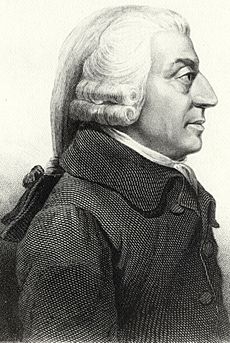
When the university started in 1451, it had four main areas of study: Arts, Divinity, Law, and Medicine. Over time, new areas like Science and Engineering were added. The Faculty of Engineering was officially created in 1923, but engineering had been taught since 1840. In 1769, James Watt's engineering work at Glasgow led to a better steam engine, which helped start the Industrial Revolution.
In 2010, the old system of faculties was changed to the current system of four larger Colleges. This was done to help different subjects work together more easily.
Academic Achievements and Reputation
| National rankings | |
|---|---|
| Complete (2021) | 31= |
| Guardian (2021) | 14 |
| Times / Sunday Times (2021) | 16 |
| Global rankings | |
| ARWU (2020) | 101–150 |
| QS (2021) |
79 |
| THE (2021) | 87= |
The University of Glasgow is a member of the Russell Group, which includes top research universities in the UK. It was also a founding member of Universitas 21, a global group of universities focused on high standards in education. The university has more "Regius Professorships" (special teaching positions created by the monarch) than any other UK university.
In global rankings, Glasgow has moved up over the years. For example, in the QS World University Rankings, it was 59th in 2011 and 51st in 2013. It is also ranked among the top 20 universities in the UK for how well its graduates find jobs.
Student Admissions
|
| Domicile and Ethnicity | Total | ||
|---|---|---|---|
| British White | 54% |
|
|
| British Ethnic Minorities | 12% |
|
|
| International EU | 4% |
|
|
| International Non-EU | 30% |
|
|
| Undergraduate Widening Participation Indicators | |||
| Female | 59% |
|
|
| Independent School | 13% |
|
|
| Low Participation Areas | 17% |
|
|
As of the 2023-2024 school year, the university had many undergraduate and postgraduate students. A large number of students, almost 40%, come from the West of Scotland. In the 2016–2017 school year, 71% of students were from the UK, 11% from the EU, and 18% from outside the EU. About 59% of students were female and 41% were male.
To get into the university, students need good grades in their A-levels or Scottish Highers. Glasgow has high entry requirements compared to other UK universities. For most courses, if Scottish applicants get very high grades, they are guaranteed a place.
Student Life at Glasgow
Unlike some other universities, Glasgow does not have just one student association. Instead, there are several groups that help students. These include two independent student unions, a sports association, and the Students' Representative Council. None of these groups are part of the National Union of Students.
Students at Glasgow also elect a Rector. The university has many different clubs and societies. These include sports teams, political groups, and gaming societies.
Students' Representative Council
The Glasgow University Students' Representative Council (SRC) is the official group that represents students. It works to make sure students' interests are heard by the university and by the government. The SRC also helps with student health and welfare. All students are automatically members of the SRC, but they can choose not to be.
The SRC organizes special weeks like Media Week and Welfare Week. It also helps fund about 130 student clubs and societies.
Student Unions
Students can also join one of the university's two student unions: the Glasgow University Union (GUU) or the Queen Margaret Union (QMU). Joining is free, and students can be members of both. These unions are places for students to socialize, eat, relax, and join activities. They also have rooms for meetings.
The two unions exist separately because the university used to be only for men. The GUU was for men, and the QMU was for women from Queen Margaret College, which later joined the university. They continue to be separate because they have different vibes. The GUU is known for sports and debates. The QMU is a popular music venue and has hosted famous bands like Nirvana and Red Hot Chili Peppers.
The GUU has won many debating championships, including the World Universities Debating Championships five times.
Sports Association
Sports at the university are managed by the Glasgow University Sports Association (GUSA). There are many different sports clubs, like Squash, Basketball, Football, and Rowing. These clubs often compete against other universities. Students who join a sports club must also join GUSA. The university also offers non-competitive sports classes for all gym members.
Mature Students' Association
Students who are 21 or older are called "mature students." They have their own group, the Mature Students' Association (MSA). The MSA provides places for mature students to relax and study. It also organizes social events and support for them.
Student Media
The university has a lively student media scene. This includes a newspaper called the Glasgow University Guardian, a magazine called Glasgow University Magazine, Glasgow University Student Television, and Subcity Radio. The Queen Margaret Union also publishes a magazine called qmunicate.
Mountaineering Club
The Glasgow University Mountaineering Club is an outdoor group for students and staff. It started officially in 1941, but students were already hiking together in the late 1930s.
Famous People from Glasgow University
Many important people have taught or studied at the University of Glasgow. These include seven Nobel Prize winners and three UK Prime Ministers: William Lamb, 2nd Viscount Melbourne, Sir Henry Campbell-Bannerman, and Bonar Law.
Other famous names include:
- Physicist Lord Kelvin
- Economist Adam Smith
- Engineer James Watt
- Inventors Henry Faulds and John Logie Baird
- Chemist Joseph Black
- Biologist Sir John Boyd Orr
- Surgeon Joseph Lister
- Writer James Boswell
- Missionary David Livingstone
- Physicist Jocelyn Bell Burnell, who discovered radio pulsars.
In 1933, Albert Einstein gave a lecture at the university and received an honorary degree. In 1974, professors Graham Teasdale and Bryan Jennett created the Glasgow Coma Scale, which is used worldwide to check brain injuries.
More recently, the university has been home to many famous writers and poets. It has also trained many politicians, including former Prime Ministers Bonar Law and Sir Henry Campbell-Bannerman. Former Scottish First Ministers Donald Dewar, Nicola Sturgeon, and Humza Yousaf also studied here. Other notable alumni include actor Gerard Butler, comedian Greg Hemphill, and musicians Emeli Sandé and Simon Neil.
-
Sir Menzies Campbell
World Changing Alumni Award
The university gives out the "World-Changing Alumni Award" to celebrate former students who have done amazing things. This award is for those who graduated in the last 15 years and have made a big difference in their community, arts, sciences, or business.
The award started in 2001 as part of the university's 550th-anniversary celebrations. It is given once a year. The trophy is presented at a graduation ceremony or a special event.
Recent winners include:
- 2024: Vitalii Klymchuk
- 2023: Daniel Crawford
- 2022: Dr Nadia Maarouf
- 2021: Fiona McPhail
- 2020: Selina Hales
- 2019: Eunice Ntobedzi
- 2018: Amal Azzudin
- 2017: Susanne Mitschke; Patrick Renner
- 2016: Matt Fountain
- 2015: Mhairi Black MP
- 2012: Katherine Grainger MBE CBE
- 2011: Emeli Sandé
See also
 In Spanish: Universidad de Glasgow para niños
In Spanish: Universidad de Glasgow para niños
- Academic dress of the University of Glasgow
- Armorial of UK universities
- Banknotes of Scotland (Gilmorehill featured on design)
- List of medieval universities
- List of universities in the United Kingdom




